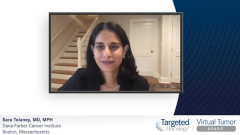
Case 1: Adjuvant Trials for HER2+ Breast Cancer
Episodes in this series

Ruta Rao, MD: Let’s talk about other agents in this adjuvant setting. What about the use of neratinib? Can you comment on the EXTENET trial data and how we should put that into context given that we’re now treating patients in the neoadjuvant setting? Dr Tolaney, do you want to start?
Sara Tolaney, MD, MPH: The EXTENET trial was a randomized phase 3 trial that looked at taking patients who had completed their year of adjuvant trastuzumab-based therapy and then randomize them to get extended adjuvant treatment with a year of neratinib or placebo. This trial demonstrated that there was an improvement in disease-free survival from adding that year of neratinib. In the overall trial, the difference was only about 2.5%, but what was quite interesting was that, if you looked at the hormone receptor–positive subgroup, that’s the group where all the benefit was seen. It was almost a 5% difference in that hormone receptor–positive group in the overall trial, whereas there was no absolute difference between the 2 arms in the hormone receptor–negative group. They did a separate subgroup analysis looking at the highest-risk patients with hormone receptor–positive disease, so those patients had residual disease after preoperative therapy that was hormone receptor–positive where they saw a little over 7% absolute difference. These data suggest that neratinib has benefit in an extended adjuvant setting, particularly in hormone receptor–positive high-risk patients.
The challenge is 2-fold. One is that it causes toxicity. It was associated with a 40% rate of grade 3/4 diarrhea, without antidiarrheal prophylaxis in this trial, however. The second is that the trial was conducted when we weren’t giving pertuzumab or T-DM1 [trastuzumab emtansine], so we don’t know what the efficacy of neratinib is in patients who have had prior pertuzumab or T-DM1 [trastuzumab emtansine].
In the current era, I take these data to say high-risk, hormone receptor–positive patients probably benefit from neratinib. I don’t know what the benefit is going to be in my patient who got pertuzumab and T-DM1 [trastuzumab emtansine], but I would use it only in those patients who really had residual disease that was node-positive, hormone receptor–positive disease after preoperative therapy, understanding it is a bit data-free. I would probably offer it to them in that situation, and I would use it with antidiarrheal prophylaxis.
Ruta Rao, MD: Thank you. Dr Jhaveri, any comments on neratinib in addition to what Dr Tolaney just said?
Komal Jhaveri, MD, FACP: No. The challenge has always been what that right patient population would be, because we are now further escalating therapy for our patients. We start out with neoadjuvant-based therapy as we made a case for most patients with stage II/III disease where we justify dual anti-HER2 [human epidermal growth factor receptor 2]–blockade with pertuzumab and trastuzumab regardless of the hormone receptor status. We have great data; we have this option for our patients, and what we struggle with is that we don’t have data specifically in the current context where we’re utilizing pertuzumab-based therapy for neoadjuvant patients, and we’re utilizing T-DM1 [trastuzumab emtansine] if there is residual disease. Yes, for your high-risk patient population, we have data from the EXTENET study for neratinib, which obviously did not account for the pertuzumab and T-DM1 [trastuzumab emtansine].
Ruta Rao, MD: Right. We’re faced with the data that we have and have to make the best decisions we can from them. Thank you both for summarizing that nicely.
Let’s get back to the KATHERINE trial for a moment. Can you discuss the recent data that we saw at ASCO [American Society of Clinical Oncology Annual Meeting] 2020 regarding this use of biomarkers for early stage HER2-positive breast cancer management?
Sara Tolaney, MD, MPH: The KATHERINE trial was a study that looked at giving T-DM1 [trastuzumab emtansine] vs trastuzumab in the adjuvant setting, and the data we saw at ASCO looked at several biomarkers that were predominantly off the residual-disease tissue. About 80% of the analysis was done from tissue obtained at the time of surgery. They looked at outcomes based on several of these biomarkers. One of them was looking at PIK3CA mutation status, and they found that T-DM1 [trastuzumab emtansine] had benefit independent of mutation status. Regardless of whether there was a mutation, T-DM1 [trastuzumab emtansine] was beneficial. They also looked at several other biomarkers, including HER2 expression. They found that patients with high HER2 expression had worse outcomes in the trastuzumab arm, but there is no difference in outcome in the T-DM1 [trastuzumab emtansine] arm. They looked at many immune biomarkers, including PD-L1 expression, and they found that patients who had low PD-L1 expression seemed to have worse outcomes in the trastuzumab arm but not in the T-DM1 [trastuzumab emtansine] arm.
They suggested that there was no biomarker that could be identified to predict a lack of benefit to T-DM1 [trastuzumab emtansine], whereas there were a couple of factors that may influence benefit to trastuzumab, such as low HER2 expression or low PD-L1 status.
Ruta Rao, MD: Excellent. Thank you for that nice summary.
Transcript edited for clarity.












































